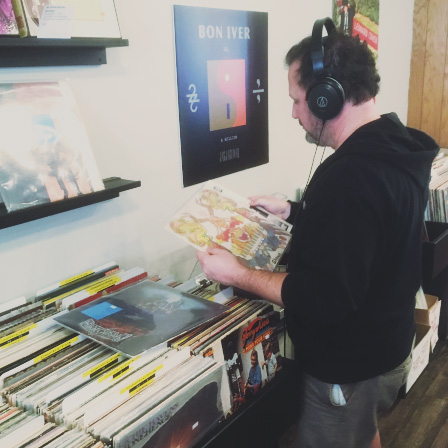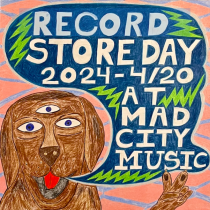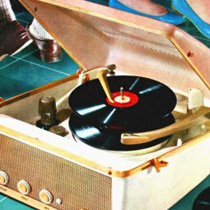Turntable Tips
Find the right turntable
Used record players, for years easily found at every garage sale or thrift store, have become a lucky score these days. But if you find a bargain, don’t forget that score might need some work to sound its best and to not damage your records. Be prepared to replace the stylus (aka, the needle), if you can identify what cartridge model is currently installed. Another option is replacing the cartridge itself with a new one; we offer some options in store and can make a recommendation.
An amazing resource for learning about any used turntable you plan to rehab is the database at vinylengine.com; manuals can be found for many models of both turntables and cartridges you may find on vintage decks. They also feature alignment protractors, which you will need if changing a cartridge on a standard-mount tonearm. Manuals and specification charts are extremely helpful for instructions on properly setting up the table, and for finding a model number if searching for a replacement stylus on that vintage cart (once you have a model number it’s easy to search online and find a current replacement).
If the table needs more help than basic set-up or a stylus (or the set-up process already seems daunting) make sure to consult a good service tech to get it up and playing properly. HiFi Haus services (and sells) used turntables and other gear … on that note, don’t forget what you will be hooking the record player up to is important, too !
While the turntable is the device that plays your music, the amplifier/receiver is the power behind it that boosts your tunes to neighbor-maddening levels. Most turntables do not have an onboard phono preamplifier, so make sure the receiver you plan to use has a “phono” input. If not, don’t despair; external phono preamplifiers are a thing, and many models aren’t that expensive. And some new turntables these days include a preamp, also an option if your existing amp doesn’t have a dedicated phono input.
https://www.hifi-haus.com/
https://www.vinylengine.com/turntable-database.php
Turntable placement
Keep the turntable away from direct exposure to sun, heat, moisture and dirt. And, as with all stereo equipment, ventilation and air flow is your friend, to avoid overheating.
Is your turntable tonearm balanced properly?
Keep your stylus clean!
How to clean your stylus: Make sure your system is completely turned off. From the back to front, and with very little pressure, gently brush the stylus with a soft brush (often a proper brush will come with a new cartridge) or Q-tip. We recommend the GrooveWasher stylus cleaning kit, available at the store. It’s ok to use rubbing alcohol or an alcohol/distilled water solution, but don’t go overboard on the moisture. Repeat cleaning every 3-4 weeks, or if you notice the sound suddenly get fuzzy or skipping is occurring on a record that didn’t skip in the past.
Vinyl Care
General everyday tips to care for your vinyl
Eliminate contact with the playing surface: When handling and playing records, hold the disk by the outer edge and label.
Store LPs vertically: As little lean as possible is the best situation, but don’t pack them too tight, either. You should be able to easily and freely insert and remove a record from between two others without difficulty. Storing records too tightly can cause unnecessary stress to the plastic, resulting in warps or cracks, and also promote ring wear or other damage to the cover. Conversely, 45s favorite orientation is horizontal. That being said, they are also fine stored vertically as long as a lot of lean or pressure is avoided. White storage boxes are available in store, and are a better option for storage than stacks of singles everywhere.
Store records in a cool, dry area: Avoid any source of heat (including direct/concentrated sunlight) as heat will warp your records. Humid or moist areas are also to be avoided for record storage. Combine warmth and humidity and you have ideal conditions for mold, mildew and other fungi which records are as susceptible to as everything else.
Proper turntable set-up: Be sure your turntable is on a level surface with the tracking force/arm weight adjusted correctly, and keep in mind how much your stylus has been used. A heavily worn or damaged stylus will damage your records, and it’s a lot easier (and cheaper) to replace a stylus than records.
Cleaning your vinyl
Deep cleaning
Most dirt and grime can be removed by hand-cleaning, using filtered or distilled water. If only water isn’t cutting whatever is on there, a 50/50 solution of denatured alcohol (which has fewer impurities) and filtered or distilled water should remove most gunk from the grooves. (Don’t want to mix your own? A great solution is the GrooveWasher “Commando Kit,” which includes a microfiber rag, solution and a cover to place over the label. Available at the store, of course!)
A good way to apply the liquid (going carefully and gently in the direction of the grooves) is either a cotton ball or makeup remover “beauty squares” from the grocery store. Keep a soft cotton or microfiber cloth handy to carefully dry off the liquid, again always going with the grooves; drying the record will also usually help remove some more residue. Don’t use paper towels to clean or dry a record, as they break down easily and often leave fibers in the grooves.
Note: Most LPs and 45s released after the early fifties are composed of polyvinyl materials that are more durable than their shellac 78 predecessors, but some formulations (such as styrene, a stiffer material used for many 45s) can react to alcohol or other cleaning solutions. If you’re not sure what the record is made of, another rinse with just water is not a bad idea.
Can you clean labels/covers?
When wet-cleaning a record, be careful not to get the labels wet. (All the GrooveWasher kits come with a cover for the label… just sayin’.)
In general, dirty covers or labels are often best left alone. Marks or stickers on matte finish covers and labels are usually difficult to remove without making the problem worse.
However, if the cover is laminated or glossy, a damp towel or one of the cleaning methods described above will sometimes work wonders. Marks or writing on the cover sometimes can be removed by carefully using a rubber eraser. Lighter fluid (naphtha) or even hair spray works great on pen marks. Stickers, labels, tape and such can sometimes be removed by heating the area with a hair dryer (of course, make sure the record is removed first). The heat softens the adhesive and makes it easier to remove the sticker with less risk of damaging the cover or sleeve. Sticker residue can be removed with most citrus-based cleaners or lighter fluid (naphtha). If attempting to use a cleaning fluid on a cover, it’s a good idea to test an inconspicuous spot to make sure it does not stain. And please remember: these techniques only work well on glossy covers.
For protecting your LP covers — as well as the records themselves — we offer a full line of plastic outer sleeves and paper inner sleeve for LPs and 45s in the store.




